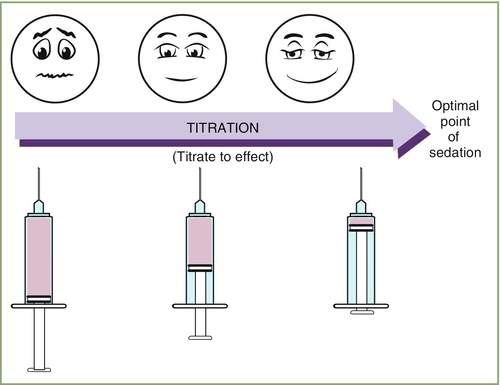Titration of N2O and O2 Gases
CHAPTER OBJECTIVES
Upon completion of this chapter, the reader should be able to:
1. Define titration as a method of drug administration.
2. Understand the significance of titration.
3. Understand the concept of individual biovariability.
4. Recognize the advantages of the ability to adjust sedation levels using N2O/O2 sedation.
Titration is a method of administering a drug in incremental amounts until a desired endpoint is reached (Box 11-1). For N2O/O2 sedation, N2O is given in incremental doses until a patient has reached a comfortable, relaxed state of sedation. The ability to titrate N2O is a significant advantage because it allows the specific amount of drug that is required by that patient to be delivered. If titration is done properly, the patient does not receive any more of the drug than is necessary. Occasionally, patients have had negative experiences with N2O/O2 sedation. In such cases, the operator most likely did not titrate properly; instead, the patient may have received an inappropriate amount of drug. The concept of titration is the single most important skill to be learned by the operator to be a competent, safe administrator of any drug by any route, including N2O (Figure 11-1). The 2006 Joint Guidelines of the AAP and AAPD state that “the concept of titration of drug to effect is critical” and specify that practitioners must know the full effect of a drug dosage before adding another.1The titration technique is regarded as the current standard of care when administering N2O/O2 for sedation.
The use of a rapid induction technique for N2O/O2 administration has been advocated by some clinicians for years. This technique involves administering a large quantity of N2O (up to 50%) initially to patients, particularly children. Advocates of this technique maintain it is necessary to quickly calm an intensely fearful or uncooperative child. This technique in skilled hands can produce favorable results. The rapid induction technique is not recommended for adults. Pinkham2 describes in the text Pediatric Dentistry: Infancy through Adolescence that the use of high concentrations with a rapid administration technique produces many negative effects.
The use of a 50% N2O and 50% O2 product may be a common practice for some. Seasoned clinicians and researchers Gillman and Lichtigfeld3 advocate the use of the titration technique and advise others that they may have improved success rates when they use this technique instead of a 50% premixed concentration. It is therefore recommended that the rapid induction of high concentrations of N2O not be used with adults; instead it should only be used with children under specific conditions and by a trained pediatric clinician.
1 Significance
A. It is extremely desirable to provide only the amount of a drug necessary for the procedure being performed. This allows for the elimination of the drug from the system, but, more importantly, it creates a positive experience for the patient. With the use of careful titration, vigilant supervision of the patient, and updated equipment, negative experiences with N2O/O2 sedation should be rare.
B. Titration is very important when administering any drug. It minimizes th/>
Stay updated, free dental videos. Join our Telegram channel

VIDEdental - Online dental courses



